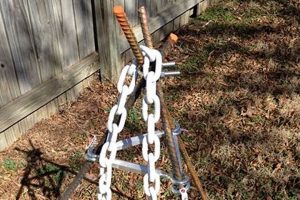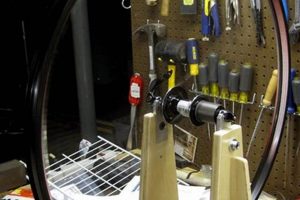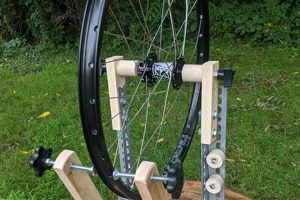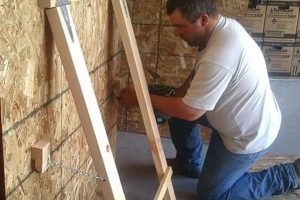The creation of a self-assembled target support structure allows for personalized shooting practice. These structures, often constructed from readily available materials, provide a stable platform for target placement in a variety of shooting disciplines. For example, a simple frame built from lumber can securely hold paper targets, while a more complex design incorporating metal components may be suitable for supporting steel targets.
The ability to fabricate these supports provides significant cost savings compared to commercially manufactured alternatives. Furthermore, a homemade approach enables customization to specific needs, such as adjusting height or incorporating portability features. Historically, individuals have built such devices out of necessity, utilizing local resources to practice marksmanship and hone skills.
The subsequent sections will delve into various designs, materials, and safety considerations involved in constructing a personalized system. Exploration of suitable material selection, structural integrity factors, and safe construction practices will be covered.
DIY Target Stand
Proper construction of a target support structure is crucial for safe and effective shooting practice. The following tips outline key considerations for building a durable and reliable system.
Tip 1: Material Selection is Paramount: Opt for materials appropriate for the intended caliber and frequency of use. Pressure-treated lumber, for example, offers resistance to weather damage when constructing outdoor stands. For steel targets, ensure the stand can withstand the impact force without collapsing.
Tip 2: Prioritize Structural Integrity: Secure joints are essential for stability. Employ screws, bolts, or welds, depending on the material, to ensure connections are robust and capable of withstanding repeated impacts and environmental factors. Consider using gussets or bracing to reinforce weak points.
Tip 3: Design for Portability (if applicable): If mobility is desired, incorporate features such as folding legs or wheels. Ensure any moving parts are securely locked in place during use to prevent accidental collapse.
Tip 4: Implement Adequate Target Suspension: Use appropriate methods to attach targets to the stand. Clamps, hooks, or staples can be used for paper targets, while chains or brackets are suitable for steel targets. Ensure the target is securely fastened to prevent movement or detachment during shooting.
Tip 5: Ensure Proper Height and Angle: Adjust the stand’s height and angle to suit the shooter’s needs and the type of shooting being practiced. This ensures comfortable and accurate shooting while maintaining safe projectile trajectory.
Tip 6: Emphasize Stability on Uneven Terrain: Incorporate adjustable feet or a wide base to ensure stability on uneven surfaces. A stable stand minimizes movement, improving accuracy and reducing the risk of ricochets.
Tip 7: Regular Inspection and Maintenance: Routinely inspect the structure for signs of wear or damage. Replace any weakened or broken components immediately to maintain the stand’s integrity and safety.
Proper attention to these details will yield a safe and reliable structure that will allow for focused training. Adherence to sound construction principles promotes responsible shooting practices.
The following sections will explore specific design considerations and safety protocols for various configurations.
1. Material Durability
Material durability constitutes a foundational element in the design and construction of a self-assembled target support structure. The selection of appropriate materials directly impacts the longevity, safety, and overall effectiveness of the device. The ability of the chosen materials to withstand environmental factors and repeated projectile impacts determines the practical lifespan of the stand.
- Weather Resistance
Exterior target supports are subject to a range of environmental conditions, including rain, sunlight, and temperature fluctuations. Utilizing materials such as pressure-treated lumber or powder-coated steel can mitigate degradation caused by these elements, extending the stand’s service life and preventing premature failure due to rot, rust, or other forms of corrosion. The absence of weather resistance results in rapid deterioration and potentially unsafe conditions.
- Impact Tolerance
The capacity of materials to withstand repeated impacts from projectiles is critical for target supports intended for live-fire practice. Steel, particularly AR500 or similar hardened alloys, offers superior impact tolerance compared to softer materials like wood or plastic. The selection of appropriate steel thickness is crucial to prevent penetration or deformation, which can compromise the stand’s structural integrity and safety. The inappropriate choice of materials that offer substandard impact tolerance is hazardous.
- Material Degradation Over Time
All materials degrade over time, but the rate and manner of degradation vary significantly. Wood can rot or become brittle, while metals can corrode or fatigue. Regular inspection and maintenance are necessary to identify signs of degradation and address them promptly. Selecting materials with inherent resistance to common degradation processes, such as galvanized steel or composite lumber, minimizes the need for frequent repairs or replacements and enhance overall safety.
- Connection Point Strength
The durability of a structure is not solely dependent on the base materials. The fasteners and connection points must be equally durable. Using corrosion-resistant screws, bolts, and welding techniques is vital to maintain structural integrity over time. Weak or corroded connections can lead to catastrophic failure, even if the primary materials remain sound. Therefore, the connection mechanisms constitute a critical aspect of material durability considerations.
In conclusion, the careful selection of durable materials and the implementation of robust construction techniques are paramount to ensuring a safe and effective structure. A neglect of this aspect increases the risk of both equipment failure and potential injury during usage.
2. Structural Integrity
Structural integrity is a paramount consideration in the design and construction of any self-assembled target support structure. It directly influences the safety and longevity of the apparatus, ensuring it can withstand the forces generated by projectile impacts without collapsing or becoming unstable. A failure in structural integrity can lead to hazardous conditions, including ricochets, falling targets, and potential injury to the shooter or bystanders.
- Joint Strength and Stability
The connections between individual components dictate the overall stability of the structure. Weak or improperly secured joints are prone to failure under stress. Using appropriate fasteners (screws, bolts, welds) and reinforcement techniques (gussets, bracing) is crucial. For example, a target stand constructed from lumber should employ screws of sufficient length and diameter, coupled with wood glue, to ensure a secure bond. Furthermore, proper angle bracing will distribute the forces evenly across the structure. Compromised joint strength directly correlates with the stand’s ability to withstand impacts and environmental stress.
- Material Load Capacity
Each material possesses a specific load capacity, representing its ability to withstand applied forces without deforming or fracturing. Exceeding this capacity can result in structural failure. When selecting materials, it is essential to consider the weight and impact forces associated with the intended targets and calibers. For instance, a target stand designed to hold steel targets requires a higher load capacity than one intended for paper targets. Calculations must account for the dynamic forces generated upon impact, which can significantly exceed the static weight of the target.
- Base Stability and Support
The base of the apparatus provides the foundation for stability. A wide and stable base distributes the weight of the stand and target, minimizing the risk of tipping or wobbling. Factors influencing base stability include the footprint size, the number of support points, and the surface on which the stand is placed. Uneven terrain necessitates the incorporation of adjustable feet or a leveling mechanism. A poorly designed base compromises the entire structure, rendering it unsafe and unreliable.
- Resistance to Environmental Factors
Outdoor target stands are exposed to environmental stressors such as wind, rain, and temperature fluctuations. These factors can weaken the structure over time, leading to corrosion, rot, or warping. Materials selected for outdoor use should exhibit resistance to these elements. Pressure-treated lumber, galvanized steel, or powder-coated surfaces offer enhanced protection. Regular inspection and maintenance are necessary to identify and address any signs of degradation before they compromise the structural integrity of the structure.
The connection between structural integrity and a self-assembled target apparatus is inextricably linked. Addressing the aforementioned facets is critical to ensuring safe and effective practice. Lack of attention to any element undermines the overall structure and introduces unnecessary risks. The responsible construction requires a meticulous approach to design and materials, emphasizing robust structural properties.
3. Target Attachment
Effective target attachment represents a crucial component of any do-it-yourself (DIY) target support structure. The method by which a target is affixed to the frame directly impacts the target’s stability, visibility, and the overall safety of the shooting environment. Improper attachment can lead to target movement during firing, hindering accuracy and potentially causing unsafe ricochet events. The design of the structure must therefore consider the type of target being used, the caliber of firearms involved, and the environmental conditions to which the stand will be exposed. For example, paper targets typically require different attachment methods than steel plates, necessitating variations in the frame design. The stability afforded by secure attachment enables focused training, reducing distraction and promoting accurate marksmanship.
Diverse methodologies exist for target attachment, ranging from simple clamping mechanisms to more complex suspension systems. Paper targets can be effectively secured using spring clamps, binder clips, or even staples, provided the stand’s frame offers appropriate anchor points. Steel targets, conversely, demand robust suspension systems capable of withstanding significant impact forces. Chain, rope, or dedicated target hangers are commonly employed for steel targets, ensuring they swing freely upon impact to dissipate energy and prevent damage to the stand. The chosen attachment method must also consider the ease of target replacement, allowing for efficient practice sessions without requiring extensive downtime. Furthermore, the attachment points on the stand should be designed to minimize wear and tear on the target itself, prolonging its lifespan and reducing replacement costs.
In summary, target attachment is not merely an ancillary detail but an integral design element of any self-constructed target support. The selection of an appropriate attachment method is driven by factors such as target material, firearm caliber, and environmental considerations. Secure attachment promotes safety, improves shooting accuracy, and maximizes the efficiency of training exercises. Therefore, any individual undertaking a DIY project to create a structure must prioritize the engineering of robust and reliable system, ensuring a functional and safe environment.
4. Portability Options
The incorporation of portability options into a self-constructed target support structure significantly enhances its versatility and practicality. The ability to easily transport and relocate a target stand expands its utility beyond fixed shooting ranges, enabling practice in diverse locations such as private property or remote training areas. Without portability considerations, a structure’s functionality becomes limited by its immobility, restricting its use to the immediate construction site. The cause-and-effect relationship is direct: the inclusion of transport features results in increased adaptability and usage scenarios. Examples of portability features include folding legs, integrated wheels, and modular designs that allow for disassembly into smaller, more manageable components.
Practical applications of portable target stands are numerous. Law enforcement agencies, for example, may utilize lightweight, easily transportable stands for rapid deployment during training exercises in varied environments. Hunters can benefit from portable stands for sighting in rifles or shotguns at remote locations prior to hunting season. Recreational shooters can conveniently transport stands to public or private shooting ranges without requiring significant physical effort or specialized vehicles. The selection of specific portability features depends on the size, weight, and intended use of the target apparatus. Considerations include the type of terrain over which the stand will be transported and the available storage space.
While portability enhances functionality, it introduces structural challenges. Folding mechanisms and detachable components can compromise the stand’s overall stability if not properly engineered. Balancing the need for easy transport with the requirement for a robust and safe platform requires careful consideration of material selection and joint design. Furthermore, adding wheels or other moving parts increases the complexity of the design and may introduce potential points of failure. Despite these challenges, the benefits of portability often outweigh the drawbacks, making it a desirable feature for DIY target stand projects, provided that structural integrity is not compromised.
5. Caliber Compatibility
Caliber compatibility represents a critical design parameter in the construction of a self-assembled target support structure. The ability of the stand to withstand the impact forces generated by various firearm calibers directly affects its safety, longevity, and overall effectiveness. Neglecting this aspect can lead to structural failure, projectile ricochets, and potential injury to the shooter or bystanders.
- Material Selection and Thickness
The choice of materials, coupled with their respective thicknesses, dictates the stand’s ability to absorb and dissipate impact energy. For low-caliber firearms such as .22 LR, lumber may suffice, while high-powered rifles necessitate the use of hardened steel. Steel target stands, in particular, must utilize abrasion-resistant steel (AR500 or similar) of appropriate thickness to prevent penetration and deformation. Insufficient material thickness will result in the target stand being damaged or destroyed with repeated use. The type of ammunition (e.g., lead, steel core) also factors into material selection, as steel-core ammunition exerts greater force upon impact.
- Weld Integrity and Joint Strength
For steel target stands, the quality of welds and the strength of joints are paramount. Weak welds are prone to failure under repeated impact, potentially causing the target to detach or the stand to collapse. Welding processes should adhere to established standards, ensuring full penetration and sufficient weld bead size. Joints should be reinforced with gussets or bracing to distribute impact forces effectively. Inadequate weld integrity presents a significant safety hazard, increasing the risk of structural failure and projectile ricochets.
- Target Mounting Methodology
The method used to mount the target onto the stand must also consider caliber compatibility. Steel targets should be suspended in a manner that allows them to swing freely upon impact, dissipating energy and reducing stress on the stand. Chains, straps, or dedicated target hangers are commonly used for this purpose. Rigid mounting methods, such as bolting the target directly to the stand, can transmit excessive force to the structure, increasing the likelihood of failure. The mounting method is a critical element in mitigating the stress of impact.
- Stand Design and Impact Distribution
The overall design of the stand can influence its ability to withstand different calibers. A-frame or H-frame designs, for example, provide greater stability and distribute impact forces more evenly than single-post designs. The angle of the target relative to the shooter also affects the amount of energy transferred to the stand. Angled targets deflect projectiles downward, reducing the risk of ricochets and minimizing stress on the structure. Careful design considerations can enhance the safety and longevity of the stand, regardless of the caliber used.
Caliber compatibility represents a non-negotiable element in the planning and execution of a construction. A comprehensive understanding of impact forces, material properties, and structural design principles is essential to create a stand that can safely and effectively accommodate the intended range of calibers. Failure to adequately address caliber compatibility increases the risk of accidents and compromises the overall functionality of the device.
Frequently Asked Questions
This section addresses common inquiries regarding the construction and utilization of self-made target support structures. The information provided aims to clarify crucial aspects for safe and effective practice.
Question 1: What constitutes the most suitable material for constructing a structure intended for high-caliber firearms?
Hardened steel, specifically AR500 or AR550, is recommended for stands designed to withstand high-caliber rounds. The thickness of the steel must be sufficient to prevent penetration. The use of lumber is not advisable for high-caliber applications due to its inadequate impact resistance.
Question 2: Are there specific safety precautions that must be observed during the construction process?
Eye protection, gloves, and appropriate welding equipment are essential when fabricating a steel apparatus. When working with lumber, precautions against splinters and dust inhalation are necessary. Always ensure a stable work environment to prevent accidents during assembly.
Question 3: How should steel targets be mounted to minimize the risk of ricochets?
Steel targets should be suspended using chains or straps that allow them to swing freely upon impact. This method dissipates energy and deflects projectiles downwards. Rigidly mounting steel targets can increase the likelihood of dangerous ricochets.
Question 4: What is the recommended distance between the shooter and the structure to ensure safe practice?
The distance is dependent on the firearm’s caliber. Consult the firearm’s manual and relevant range safety guidelines to determine the minimum safe distance. A general rule of thumb is to maintain a distance of at least 100 yards for rifles and 25 yards for pistols.
Question 5: How often should a self-made apparatus be inspected for signs of wear or damage?
The apparatus should be inspected before each use. Pay close attention to weld points, fasteners, and the overall structural integrity. Any signs of cracking, bending, or corrosion should be addressed immediately to prevent potential failure.
Question 6: Is it permissible to utilize a self-made target structure on a public shooting range?
Public shooting ranges often have specific regulations regarding the types of targets and structures allowed. It is imperative to contact the range management prior to bringing a self-made structure to ensure compliance with all applicable rules and safety guidelines.
Adherence to these guidelines promotes safe and responsible use of homemade targets. Prioritizing safety during construction and operation is essential for preventing accidents and maximizing enjoyment.
The subsequent section will provide a detailed overview of design considerations for specific applications.
Conclusion
This exploration has emphasized the essential considerations for constructing a self-assembled apparatus. Material selection, structural integrity, safe target attachment, portability options, and caliber compatibility have been identified as critical factors. A thorough understanding of these elements is paramount for creating a safe and functional product.
Responsible implementation of these principles will contribute to safer and more effective shooting practices. Prioritize safety, adhere to established guidelines, and exercise caution when utilizing homemade target support structures. Further research and continuous evaluation of designs are encouraged to advance the state of DIY solutions within the shooting sports community.







